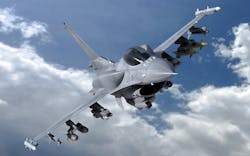Lockheed Martin to upgrade avionics and electronic systems on Taiwan's legacy fleet of F-16A/B jet fighters
WRIGHT-PATTERSON AFB, Ohio – Combat jet avionics experts at Lockheed Martin Corp. will upgrade electronic systems aboard Taiwan's fleet of 144 F-16 A/B Block 20 Fighting Falcon jet fighters to the F-16V configuration under terms of a $138 million order announced Monday.
Officials of the U.S. Air Force Life Cycle Management Center at Wright-Patterson Air Force Base, Ohio., are asking the Lockheed Martin Aeronautics segment in Fort Worth, Texas, upgrade avionics subsystems on Taiwan's legacy F-16 jet fighters.
The order calls for Lockheed Martin to upgrade Taiwan F-16 automatic ground collision avoidance system and AGM-88 high-speed anti-radiation missile (HARM); improve radar software maturity; update data acquisition systems; and upgrade the advanced identification friend or foe avionics for the Taiwan Retrofit Program F-16 Block 20 fleet.
These avionics upgrades are part of the $5.3 billion Peace Phoenix Rising 2 (PPR2) program to upgrade the Taiwan air force F-16 combat jets. Taiwan received its first upgraded F-16 in 2018, and the project should be completed by 2023.
The Lockheed Martin F-16V configuration is an option for new-production F-16s and F-16 upgrades, and uses a common worldwide sustainment infrastructure to provide capability improvements, Lockheed Martin officials say.
The core of the F-16V configuration is an active electronically scanned array (AESA) radar; a modern commercial off-the-shelf (COTS) avionics subsystem; a large-format high-resolution display; and a high-volume high-speed databus.
The F-16V also includes a Link-16 theater data link, Sniper advanced targeting pod, advanced weapons, precision GPS navigation, and the automatic ground collision avoidance system (Auto GCAS).
The Northrop Grumman advanced APG-83 AESA radar delivers situational awareness, quick all-weather targeting, target area detail, and digital map displays with slew and zoom features. The APG-83 provides uses hardware and software from the F-22 and F-35 AESA radars.
The APG-83 AESA radar can track more than 20 targets, provides high-resolution synthetic aperture radar (SAR) maps for precision strike, interleaved air-to-air and air-to-surface mode operations for improved situational awareness, and electronic protection for operations in dense radio frequency (RF) environments.
The F-16V also has a center pedestal display to give pilots tactical imagery on a high-resolution 6-by-8-inch screen, with color moving maps, large manage air-to-air situation displays, zoom, the ability to switch information among displays, and digital display of flight instrument data.
On this order Lockheed Martin will do the work in Fort Worth, Texas, and in Taiwan, and should be finished by September 2022. For more information contact Lockheed Martin Aeronautics online at www.lockheedmartin.com, or the Air Force Life Cycle Management Center at www.aflcmc.af.mil.
About the Author
John Keller
Editor-in-Chief
John Keller is the Editor-in-Chief, Military & Aerospace Electronics Magazine--provides extensive coverage and analysis of enabling electronics and optoelectronic technologies in military, space and commercial aviation applications. John has been a member of the Military & Aerospace Electronics staff since 1989 and chief editor since 1995.
